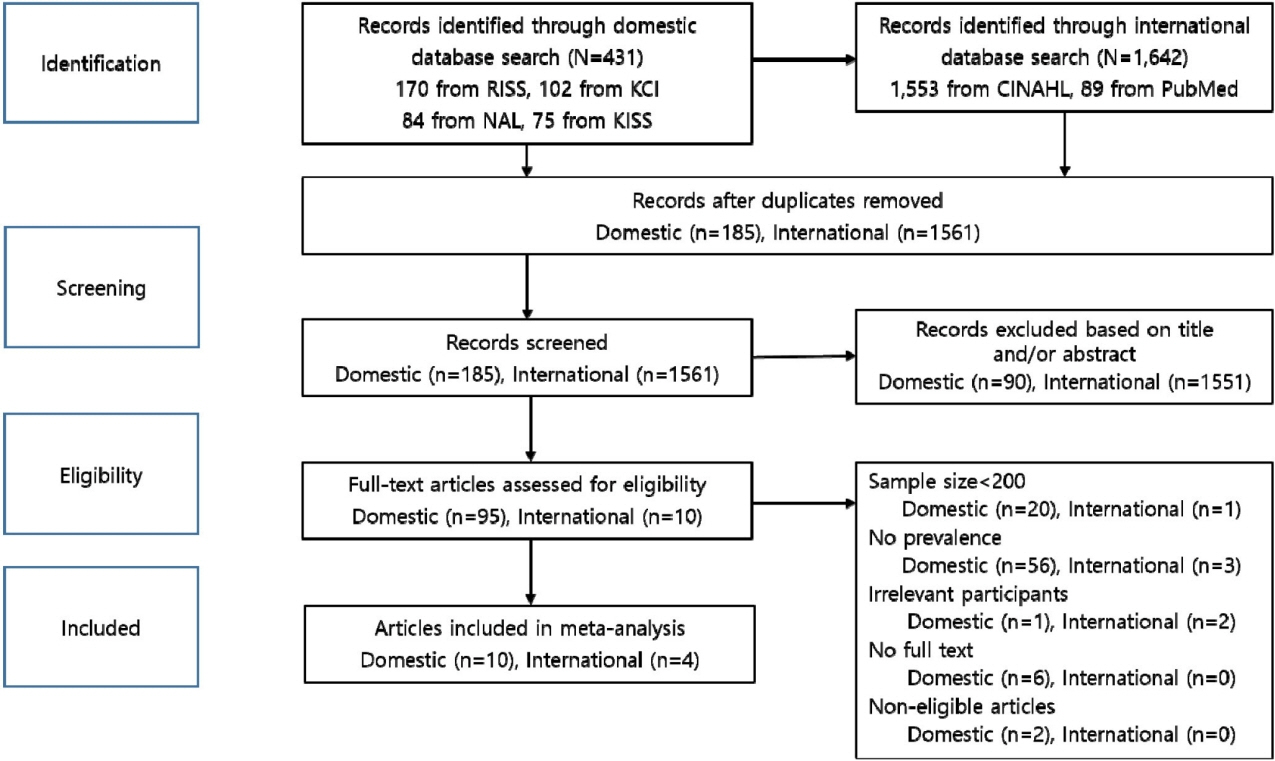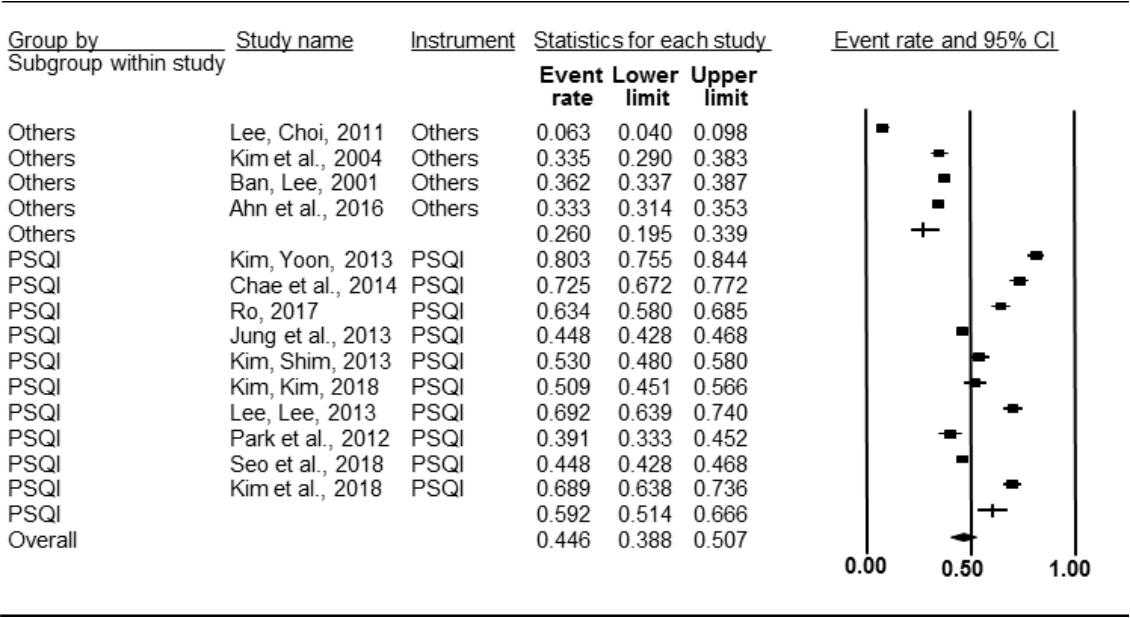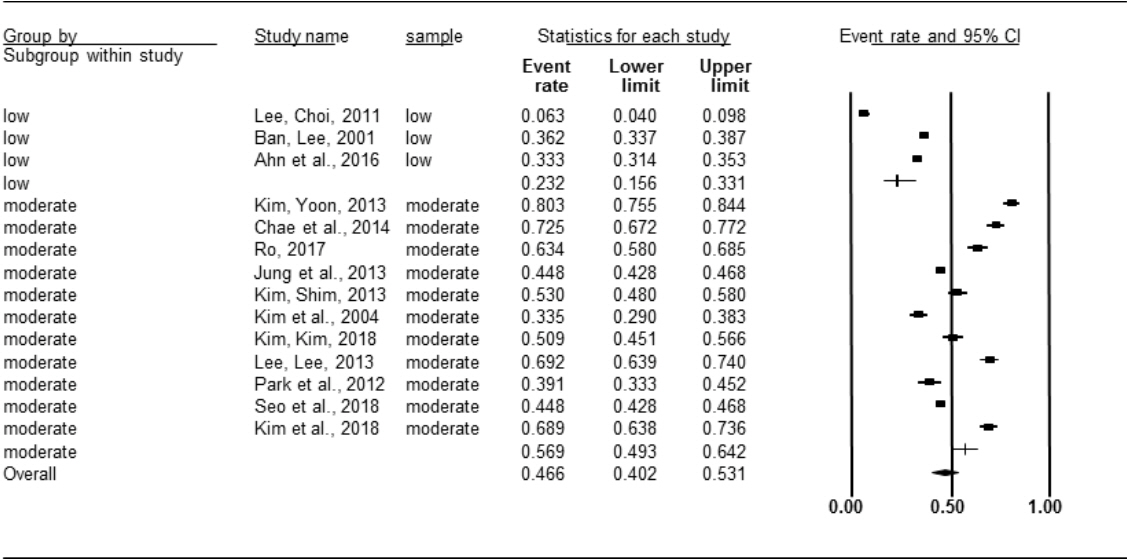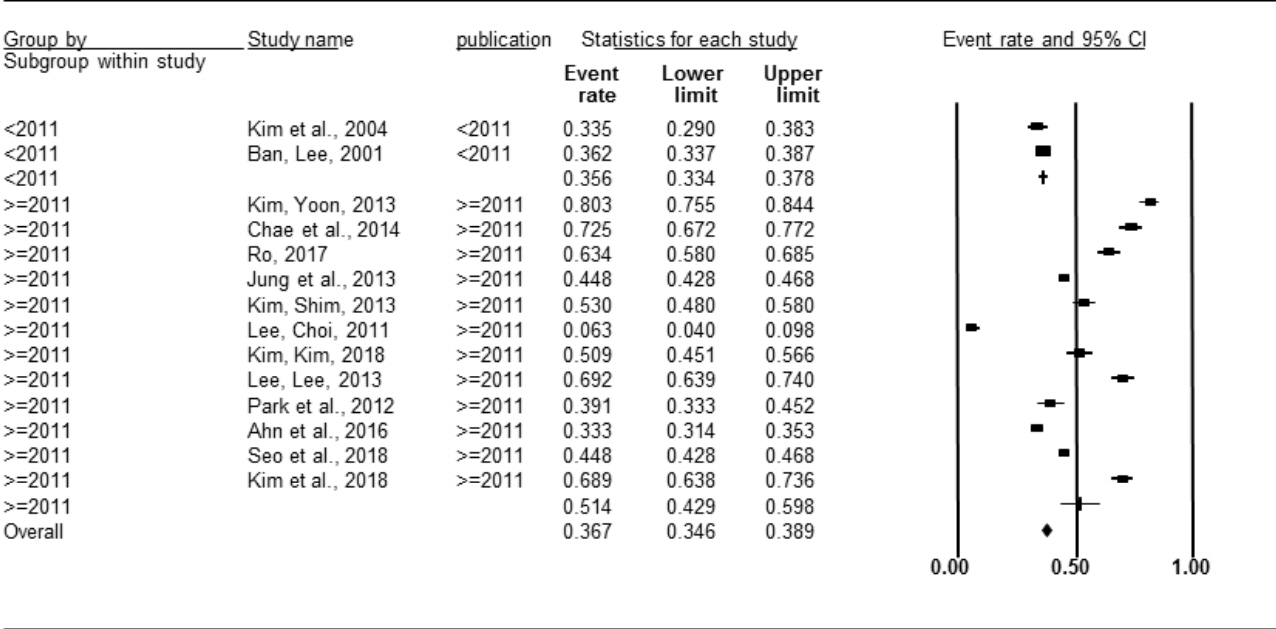한국 대학생의 수면장애 유병률: 체계적 문헌고찰 및 메타분석
Prevalence of Sleep Disturbance in Korean University Students: A Systematic Review and Meta-Analysis
Article information
Abstract
연구배경
본 연구는 한국 대학생의 수면장애 실태와 유병률을 파악하고, 수면에 대한 한국의 사회문화적 특성의 영향력을 논의하며 이를 기반으로 적절한 수면장애 증진 방안을 개발의 필요성에 대한 근거를 제시하고자 하였다.
방법
문헌은 인터넷 기반 전자 데이터베이스를 활용하여 검색하였다. 국외 DB는 PubMed, CINAHL 검색 엔진을 이용하였고, 국내 DB는 한국교육학술정보원, 국회도서관, 한국학술정보, 한국학술지인용색인의 검색엔진을 이용하였다. 검색어는 한국(Korea), 대학생(university students, college students), 수면장애(sleep disturbance), 불면증(insomnia)을 포함하였다. 문헌 검색 결과 총 1,843개의 문헌이 검색되었으며, 중복된 문헌을 제외하고, 최종적으로 분석에 포함된 연구는 총 14편이었다. 메타분석을 위한 통계적 분석은 comprehensive meta-analysis를 이용하였다.
결과
수면장애 유병률은 48.9% (95% CI, 41.6-56.3%)였다. 수면장애를 평가하기 위해 사용한 도구에 따라 하위집단 메타분석을 실시한 결과, PSQI를 이용한 연구의 수면장애 유병률은 59.2% (95% CI, 38.8-50.7%)였고, PSQI가 아닌 도구를 이용한 연구의 수면장애 유병률은 26.0% (95% CI, 19.5-33.9%)였다. 대상 연구들의 질평가 점수 결과에 따라 하위집단 메타분석을 실시한 결과, low quality 연구의 수면장애 유병률은 23.2% (95% CI, 15.6-33.1%)였고, moderate quality 연구의 수면장애 유병률은 56.9% (95% CI, 49.3-64.2%)였다. 대상 연구들의 출판 연도에 따라 하위집단 메타분석을 실시한 결과, 2010년 이전에 출판된 연구의 수면장애 유병률은 35.6% (95% CI, 33.4-37.8%)였고, 2011년 이후에 출판된 연구의 수면장애 유병률은 51.4% (95% CI, 42.9-59.8%)였다.
결론
본 연구 결과를 통해 한국 대학생은 다른 나라의 대학생에 비해 수면장애 유병률이 높아 흔하게 경험하고 있다는 것을 알 수 있다. 수면의 문제는 대학생의 남은 인생 기간 동안의 건강에 영향을 미치는 중요한 요인이 되기 때문에 한국 대학생의 수면장애 문제의 확인과 관련 요인, 중재 방안을 마련하는 미래지향적인 통찰이 필요하다.
Trans Abstract
Background
This systematic review and meta-analysis aimed at investigating the current status and prevalence of sleep disturbance in Korean university students and provide evidence to develop appropriate strategies for improving sleep disturbance.
Methods
Pooled prevalence of sleep disturbance in Korean university students was assessed using PubMed, CINAHL, Research Information Sharing Service, National Assembly Library, Korean studies Information Service System, and Korea Citation Index databases. A total of 1,843 studies were retrieved from the literature search, and 14 studies were included in the analysis. Statistical analysis was performed using comprehensive meta-analysis software.
Results
The overall pooled prevalence was 48.9% (95% confidence interval [CI], 41.6-56.3%). Subgroup analyses revealed that the pooled prevalence rates were 59.2% (95% CI, 38.8-50.7%) in the Pittsburgh Sleep Quality Index (PSQI)-based and 26.0% (95% CI, 19.5-33.9%) in non-PSQI-based studies, 23.2% (95% CI, 15.6-33.1%) in low-quality and 56.9% (95% CI, 49.3-64.2%) in moderate-quality studies, 35.6% (95% CI, 33.4-37.8%) in studies published before 2010 and 51.4% (95% CI, 42.9-59.8%) in studies published since 2011.
Conclusions
The prevalence of sleep disturbance is higher in university students. Therefore, further studies are needed to identify sleep problems of university students and gain future-oriented insights to develop mediation strategies.
INTRODUCTION
Good sleep is essential for the good health of an individual, especially for a university student. Among university students, sleep health is poor, and sleep deprivations are at warning levels [1], potentially leading to physical and mental health risks [2]. In fact, university students have a higher tendency of depression [3], and their academic performances are adversely affected by poor sleep health. Chronic sleep deprivation is associated with a broad-spectrum of negative effects on leadership, critical thinking, and academic credit [4].
University students are more likely to have irregular lives as they start their independent and autonomous university lives [5]. After competing for the university entrance examination, university students are apt to live a freewheeling lifestyle, and it is difficult to have a healthy living habit due to the burden of preparing for employment, thus leading to irregular and insufficient sleep patterns. In the previous studies conducted with college students, sleep was reported to be closely related to interpersonal relationships and mental health. Interpersonal problems and mental health were significant predictors of sleep quality in college students [6]. Further, low quality of sleep affects interpersonal deviant behaviors [7].
Especially, as the usage rate of smartphones increased, smartphone addiction also increased. These factors have been demonstrated to have significant effects on the quality of sleep [8]. Smart phone addiction was negatively correlated to sleep quality, and depression mediated the effects of smart phone addiction on sleep quality [9]. Therefore, sleep health of the so-called smart generation is more threatened.
Globally, the prevalence of sleep disturbance among university students ranges broadly from 3.0% to 74.2% [10], e.g., Thailand, 3.0% [11]; the United States, 22.5% [12]; China, 25.7% [10]; Japan, 33.3% [13]; and Saudi Arabia, 74.2% [14]. Notably, the prevalence of sleep disturbance in Korean university students ranges from 6.3% to 80.3% in different studies [15,16]. The inconsistent findings may be because of different definitions and measurements of sleep, subjective evaluation of sleep quality, and various factors influencing sleep. Many approaches can be used to evaluate sleep disturbance, such as the Pittsburgh Sleep Quality Index (PSQI) and the Insomnia Severity Index. Different assessment methods and tools questioning an individual’s experience with sleep disturbance and subjective perception of sleep quality may result in varied prevalence rates of sleep disturbance in different studies. Therefore, a systematic review and meta-analysis is needed to clarify the prevalence of sleep disturbance in Korean university students and discuss the effect of Korean socio-cultural characteristics on sleep health.
Accordingly, this systematic review and meta-analysis aimed at investigating the current status and prevalence of sleep disturbance in Korean university students. The findings would help develop appropriate strategies for the improvement of sleep disturbance.
METHODS
1. Research design
This study performed systematic literature reviews and assessed the effect size using quantitative results of individual study on the prevalence of sleep disturbance in Korean university students.
2. Literature search strategy
Literature was searched up to February 2019 using an internet-based electronic database (DB). The used search engines included PubMed and CINAHL for foreign DB and Research Information Sharing Service, National Assembly Library, Korean studies Information Service System, and Korea Citation Index for Korean DB. The search keywords included Korea, university students, college students, sleep disturbance, and insomnia.
3. Literature selection and exclusion criteria
Literature selection was carried out by two researchers. Discrepancies were resolved by discussions in case of different views. The literature selection criteria were as follows: 1) cross-sectional studies on Korean university students since 2000, 2) studies investigating the prevalence of sleep disturbance or insomnia, 3) baseline cross-sectional data from a longitudinal study or a trial before group allocation, 5) studies with a sample size of ≥200, and 6) publications written in English or in Korean. The literature exclusion criteria were as follows: 1) theses, review articles or abstracts presented in an academic conference, 2) case studies, and 3) articles with no information on response rates.
In case of the independent t-test, it was found that the statistical power of 95% or more could be secured when the total sample size was 200 or more in the medium of the effective size. This is the reason why a study with a sample size of 200 or more was selected.
4. Evaluation of the study quality
Two researchers independently evaluated the methodological quality of the selected studies using an assessment tool [17,18]. Each of the included articles scored one point for each of the following markers: 1) Is the target population clearly defined; 2) Was either of the following ascertainment methods used (probability sampling, entire population]; 3) Is the response rate >70%; 4) Are non-responders clearly described; 5) Is the sample representative of the target population; 6) Were data collection methods standardized; 7) Were validated criteria used to assess for the presence/absence of disease; and 8) Are the estimates of prevalence given with confidence intervals and in detail by subgroup. Each study was scored as follows: 0-3, low quality; 4-6, moderate quality; and 7-8, high quality. Disagreements were discussed by the two researchers until a consensus was reached.
5. Data analysisc
Characteristics of the included articles, including research design, number of subjects, selection and exclusion criteria, measurement variables and tools, outcome variables, and statistics were analyzed, coded, and summarized. To maintain accuracy in this process, two researchers performed independent evaluations. The results of the evaluation were cross-checked, and the agreement level between the evaluators was assessed.
The outcome was the proportion of Korean university students with sleep disturbance. The effect size was the prevalence of sleep disturbance. Statistical analysis was conducted using comprehensive meta-analysis software version 2.2.064 (Biostat, Englewood, NJ, USA).
The Higgins I2 homogeneity test was used to statistically analyze the results of each study. When the value of I2 is less than 25%, statistical heterogeneity is considered low. When the value of I2 is more than 50%, statistical heterogeneity is considered high [19]. Since the homogeneity hypothesis was rejected, the random effect model (the effective size and 95% confidence interval [CI]) was used in this study. We conducted subgroup analyses to control for a number of moderating factors due to heterogeneity. Funnel plots and Egger’s linear regression asymmetry test was used to test the publication biases and sensitivities of the retrieved publications [20].
RESULTS
1. Literature search
A total of 1,843 publications were obtained, including 201 domestic and 1,642 international articles. After reviewing the titles and abstracts of these publications and removing duplicate articles, 105 publications (95 domestic and 10 foreign) were found to meet the inclusion criteria. After reviewing the original literature, 14 articles (10 domestic and four international were included in the final analysis (Figure 1).
2. General characteristics of the included studies
A total of 14 publications were included in the systematic review for the evaluation of the prevalence of sleep disturbance in Korean university students. The characteristics of each publication are shown in Table 1. Quality was evaluated according to the criteria. The maximum possible score for quality is 8. Actual scores ranged from 2 to 6. A convenience sampling method was used for the 14 studies. The number of samples per study varied from 291 to 2,338, and four studies had more than 1,000 samples; in most of the studies, data were analyzed in about 300 samples. In total, 10 studies used PSQI as the method of measuring the quality of sleep. When the PSQI tool was used, the cut-off scores for determining sleep disturbance were six or more in six studies and five or more in three studies. In one study [5], the cut-off score was unclear. The prevalence ranged from a minimum of 6.3% to a maximum of 80.3%. The prevalence rates of sleep disorders were 50% or more in six studies, 30-50% in six studies, and less than 30% in two studies.
3. The overall prevalence of sleep disturbance
Sleep disturbance is a concept encompassing difficulty in initiating sleep, difficulty in maintaining sleep, early morning awakenings, non-restorative sleep, and poor sleep quality [10]. In this study, all these sleep problems along with insomnia were included in sleep disturbance. The included studies were found to not be homogeneous (I2=98.14%, P<0.001). Therefore, they were analyzed using the random effect model (Figure 2). The pooled prevalence was 0.489, indicating that about 48.9% (95% CI, 41.6-56.3%) of the Korean university students had sleep disturbance.
4. Subgroup analysis of the prevalence of sleep disturbance
Meta-analyses of subgroups showed that the prevalence rates of sleep disturbance were 59.2% (95% CI, 38.8-50.7%) in the PSQI-based studies and 26.0% (95% CI, 19.5-33.9%) in the non-PSQI-based studies based on the tools used to assess sleep disturbance (Figure 3), 23.2% (95% CI, 15.6-33.1%) in the low-quality studies and 56.9% (95% CI, 49.3-64.2%) in the moderate-quality studies based on the quality evaluation scores (Figure 4), and 35.6% (95% CI, 33.4-37.8%) in the studies published before 2010 and 51.4% (95% CI, 42.9-59.8%) in the studies published since 2011 based on the year of publication (Figure 5).
5. Publication bias
Funnel plot and Egger’s test results showed publication bias in these included studies. To assess the degree of severity of bias, a re-analysis was performed using the trim-and-fill method. As a result, three studies were excluded, and the recalculated prevalence of sleep disturbance was 41.7% (95% CI, 34.3-49.5%).
DISCUSSION
This meta-analysis investigated the prevalence of sleep disturbance in Korean university students and analyzed 14 studies published since 2000. We found that the prevalence of sleep disturbance in Korean university students was 48.9% (95% CI, 41.6-56.3%), which was higher than the prevalence rate of 25.7% in Chinese university students [7] and that of 33.3% in Japanese university students [13]. The prevalence of sleep disturbance in Korean university students is about 2.6 times higher than that in universities worldwide (18.5%) [21], and higher than that of health care providers with labor-intensive characteristics (39.2%) [22]. Korean university students who spent most of their high school days preparing for university entrance examinations are easily exposed to a smoking and drinking environment when they start university life, and their lifestyle rhythms are easily broken. They experience chronic fatigue and anxiety, which lead to sleep disturbance and lower sleep quality [23]. In addition, as social activities for economic independence and efforts for job preparation increase, there are changes to overall sleep patterns, including nighttime lack of sleep and daytime sleepiness [24]. The high prevalence rate of sleep disturbance in Korean university students in this meta-analysis can be attributed to the traditional and socio-cultural characteristics of Korea. Based on the findings in this study, Korean university students have the highest prevalence rate of sleep disturbance among those in Asian countries. In a study on the stress of university students in three countries (Korea, Japan, and China) [25], the percentages of respondents who answered that they were not stressed were 8.8% in China, 8% in Japan, and 1.1% in Korea. Regarding the cause of stress, it was found that “study” was significantly higher in Korean university students, “career” and “employment” in Chinese university students, and “human relation” in Japanese university students. In other words, Korean university students experience relatively higher academic stress than Chinese and Japanese university students. However, Korean university students make fewer efforts towards sleeping, a way of stress management, than Chinese university students [26], and these factors may be related to the high prevalence of sleep disturbance in Korean university students.
Most of the included studies used the PSQI validation tool to assess sleep disturbance because the PSQI is a worldwide sleep measurement tool. There was a difference in prevalence of sleep disturbance between studies with different screening instruments [7]. Thus, it should be noted that the tools, which were different across the studies, may affect the findings to some extent. The prevalence rates of sleep disturbance were 59.2% in the PSQI-based studies and 26.0% in other studies, indicating that the sensitivity of the PSQI tool is higher. A meta-analysis [10] showed that the prevalence rates of sleep disturbance in Chinese university students were 47.2% if the PSQI scores were 6 or more, 21.1% if the PSQI scores were 8 or more, and 15.5% if the PSQI scores were 8.5 or more. In this study, the PSQI scores of 5 or 6 points were selected as the cut-off criteria, probably leading to the higher prevalence of sleep disturbance. In most studies on Chinese university students, the cut-off point of PSQI was eight [10]. Notably, the cut-off criterion used in Korean PSQI studies ranged from five to nine [25-29]. The evaluation of sleep quality should reflect not only socio-cultural characteristics, but also development characteristics of the participants. Therefore, further studies with proper assessment tools and reasonable cut-off criteria are needed to evaluate sleep quality in Korean university students who are in late adolescence or in early adulthood.
In addition, the prevalence of sleep disturbance was higher in moderate-quality studies (56.9%) than in low-quality studies (23.2%). The findings are inconsistent with those in a previous study [30]. In the present study, three studies with low-quality scores of three or less were included in the analysis. The sleep quality in these three studies was not assessed using the PSQI, and two of the three studies analyzed sleep disturbance with subjective experiences. The higher prevalence of sleep disturbance was observed in studies using validated tools. Therefore, it is important to accurately identify sleep disturbance using validated tools. Accordingly, it is necessary to verify the cut-off criteria as well as the validation process to more accurately evaluate the prevalence of sleep disturbance in Korean university students in the future. Further studies are needed to identify the prevalence of sleep disturbance through these processes.
To examine whether increased use of smart devices affects the quality of sleep [6], we compared the prevalence of sleep disturbance in studies published before 2010 and those published after 2011. It was found that the prevalence rates were 35.6% in studies published before 2010 and 51.4% in those published after 2011, further supporting the previous findings about the effects of smart devices on the quality of sleep. However, of the 14 studies included in this systematic review, only two studies were published before 2010. Therefore, whether the differences in the prevalence in this study are related to the use of smart devices remains unclear. Further studies are needed to investigate the relationship between the prevalence of sleep disturbance and the use of smart devices.
This meta-analysis has some limitations. First, the tools and evaluation criteria for sleep disturbance were different in the included studies. Thus, there are limitations in interpreting the results. Second, the characteristics of the study participants, such as sex, major, and comorbid diseases were not presented. Therefore, we could not conduct various analyses according to these characteristics. Third, search engines, such as the Korean Medical Study DB or EMBASE may not be included, so some study results might be missing. Fourth, only a few studies fit the selection criteria, and heterogeneity and publication bias existed among the study participants. Therefore, the prevalence of sleep disturbance may be higher or lower than the actual values. Despite these limitations, this systematic review and meta-analysis is the first to investigate the prevalence of sleep disturbance in Korean university students.
Our findings indicate that Korean university students are more likely to experience sleep disturbance than university students in other countries. Since the problem of sleep is an important factor affecting the health of university students for the rest of their lives, further studies are needed to identify the relevant factors that affect sleep quality and develop mediation strategies for university students.






